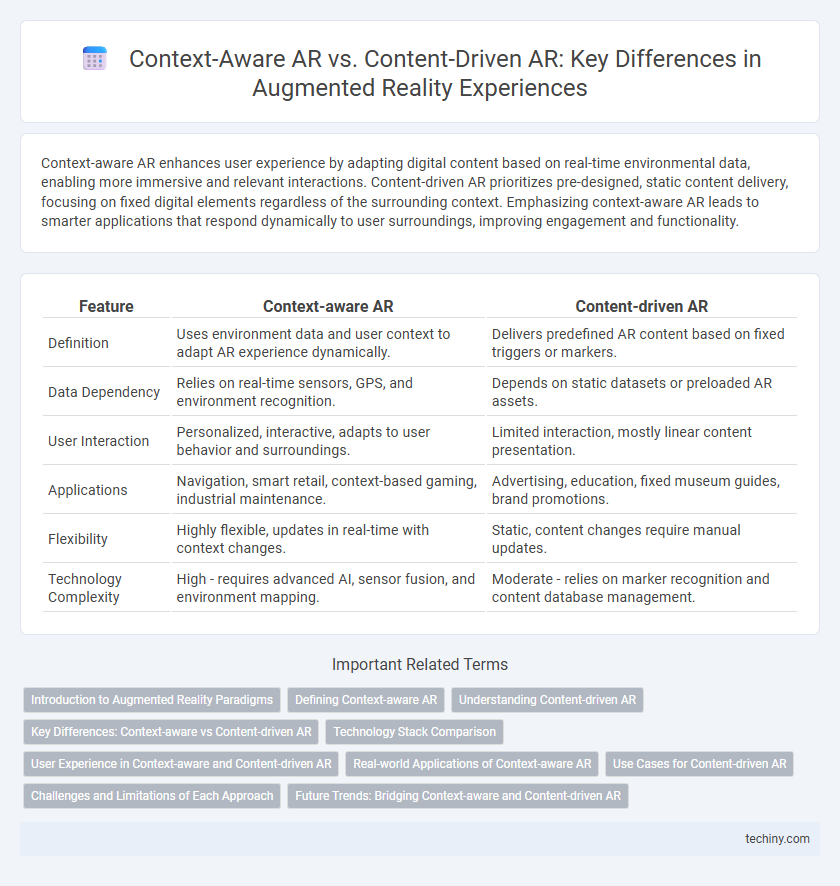Context-aware AR enhances user experience by adapting digital content based on real-time environmental data, enabling more immersive and relevant interactions. Content-driven AR prioritizes pre-designed, static content delivery, focusing on fixed digital elements regardless of the surrounding context. Emphasizing context-aware AR leads to smarter applications that respond dynamically to user surroundings, improving engagement and functionality.
Table of Comparison
| Feature | Context-aware AR | Content-driven AR |
|---|---|---|
| Definition | Uses environment data and user context to adapt AR experience dynamically. | Delivers predefined AR content based on fixed triggers or markers. |
| Data Dependency | Relies on real-time sensors, GPS, and environment recognition. | Depends on static datasets or preloaded AR assets. |
| User Interaction | Personalized, interactive, adapts to user behavior and surroundings. | Limited interaction, mostly linear content presentation. |
| Applications | Navigation, smart retail, context-based gaming, industrial maintenance. | Advertising, education, fixed museum guides, brand promotions. |
| Flexibility | Highly flexible, updates in real-time with context changes. | Static, content changes require manual updates. |
| Technology Complexity | High - requires advanced AI, sensor fusion, and environment mapping. | Moderate - relies on marker recognition and content database management. |
Introduction to Augmented Reality Paradigms
Context-aware AR leverages environmental data such as location, time, and user activity to deliver personalized and relevant augmented experiences, enhancing situational understanding. Content-driven AR focuses on embedding specific digital content triggered by markers or predefined elements, emphasizing rich media integration over environmental interaction. Both paradigms serve distinct purposes: context-aware AR excels in adaptive and dynamic applications, while content-driven AR is ideal for curated, static augmentations.
Defining Context-aware AR
Context-aware AR dynamically adapts digital content based on real-time environmental data, user location, and behavioral patterns to enhance user interaction. It leverages sensors, GPS, and machine learning algorithms to provide personalized and relevant augmented experiences. This approach contrasts with content-driven AR, which relies on pre-defined digital assets without real-time contextual adaptation.
Understanding Content-driven AR
Content-driven AR emphasizes the integration of digital information based on real-time analysis of user interactions and environmental data, enhancing personalized experiences. By leveraging machine learning algorithms and semantic recognition, it dynamically adapts content to user preferences and situational contexts. This approach enables more immersive and relevant augmented reality applications compared to context-aware AR, which primarily relies on static environmental factors.
Key Differences: Context-aware vs Content-driven AR
Context-aware AR adapts digital content based on real-time environmental data and user location, enhancing interaction through sensors and context recognition. Content-driven AR relies primarily on predefined digital assets and scripted interactions, focusing on static or planned content delivery. Key differences lie in responsiveness, where context-aware AR offers dynamic user experiences, while content-driven AR emphasizes controlled, content-specific presentations.
Technology Stack Comparison
Context-aware AR leverages sensor data, GPS, computer vision, and machine learning to adapt digital content dynamically based on the user's environment, requiring technologies like ARKit, ARCore, and SLAM algorithms for real-time spatial mapping. Content-driven AR relies on pre-defined triggers such as QR codes, image recognition, or predefined markers, utilizing tools like Vuforia, Wikitude SDK, and marker-based tracking systems to deliver static or interactive digital assets. The technology stack of context-aware AR demands higher computational power and sophisticated environmental processing, whereas content-driven AR emphasizes robust content management systems and accurate trigger detection for seamless user experiences.
User Experience in Context-aware and Content-driven AR
Context-aware AR enhances user experience by adapting digital content based on real-time environmental data, allowing seamless interaction with the surroundings. Content-driven AR prioritizes curated digital content, delivering rich and immersive experiences through highly detailed overlays regardless of changing context. Combining both approaches optimizes user engagement by balancing dynamic context sensitivity with high-quality content presentation.
Real-world Applications of Context-aware AR
Context-aware AR leverages environmental data and user context to deliver tailored, interactive experiences, enhancing applications in fields like healthcare, manufacturing, and retail. In healthcare, it supports surgeons with real-time patient data overlay, improving precision during operations. Manufacturing benefits from context-aware AR through maintenance guidance that adapts to machine conditions, while retail environments use it for personalized product visualization based on customer preferences and location.
Use Cases for Content-driven AR
Content-driven AR enhances user engagement by overlaying digital information based on specific content triggers such as images, QR codes, or text patterns. Use cases include interactive marketing campaigns, where product packaging activates immersive brand experiences, and educational apps that provide detailed information when scanning textbooks or museum exhibits. This approach excels in delivering tailored, contextually relevant content without relying on environmental awareness, making it ideal for retail, training, and entertainment applications.
Challenges and Limitations of Each Approach
Context-aware AR faces challenges in accurately interpreting dynamic environmental data and user intent, often resulting in limited responsiveness and increased computational demands. Content-driven AR struggles with maintaining relevance and personalization as it relies heavily on pre-defined content, leading to potential mismatches with real-world scenarios and user contexts. Both approaches encounter limitations in scalability and user experience satisfaction due to the balance needed between system complexity and real-time interactivity.
Future Trends: Bridging Context-aware and Content-driven AR
Future trends in augmented reality emphasize bridging context-aware AR, which leverages environmental and user data for real-time adaptive experiences, with content-driven AR that prioritizes rich, pre-designed digital assets. Advances in AI and machine learning will enable seamless integration, unlocking highly personalized and immersive interactions that dynamically respond to user context while delivering curated content. This convergence promises transformative applications in sectors like education, healthcare, and retail, driving AR innovation beyond current limitations.
Context-aware AR vs Content-driven AR Infographic

 techiny.com
techiny.com